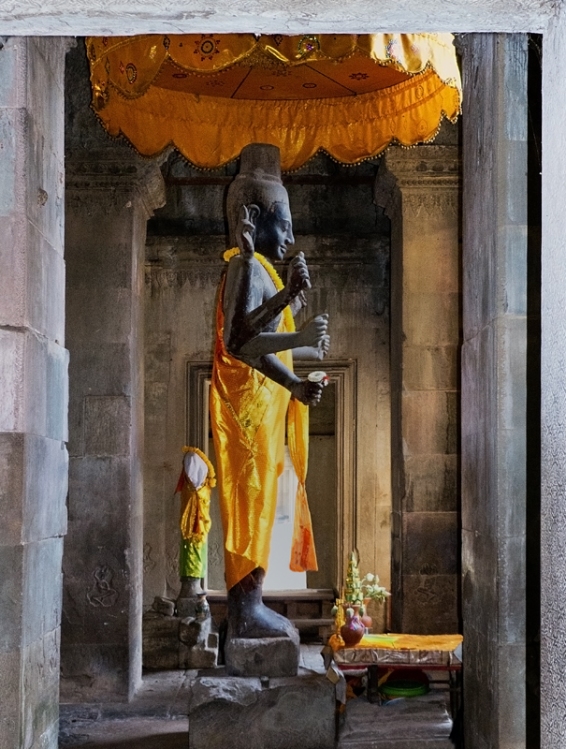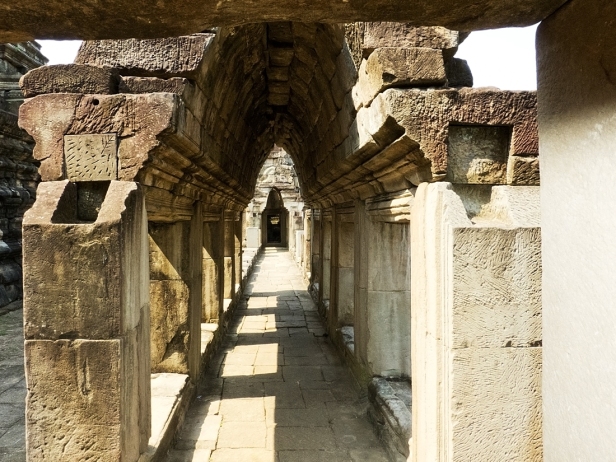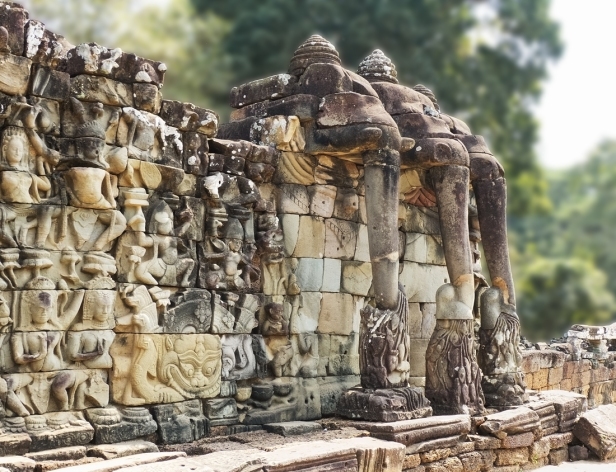14-21 January 2013. Siem Reap is Cambodia’s premier tourist mecca primarily because of the nearby extraordinary and extensive archaeological ruins. Don and I are not archaeology buffs, or history buffs, by any stretch, but there are some sites, and sights, in the world that are worth seeing anyway, even if detailed knowledge of ancient buildings is not your thing. There are over one thousand temples in the Angkor area, ranging from nondescript piles of rubble to the magnificent moat-surrounded Angkor Wat.
A stupa is a mound or tower built over an important religious or royal person’s remains. We saw many stupas in our travels. There are a few Buddha stupas in South East Asia – everyone claims to have a bone, or a hair, or something or other from the Buddha, and the relic has been ‘buried’ under a huge elaborate tower that is a focus of worship and meditation in much the same way a temple is.
We also saw many wats, wat being the Khmer word for temple, or temple grounds. Nothing compared in size and grandeur to Angkor. Actually there’s not much in the world anywhere that compares in size and grandeur to Angkor.
Super stupa Wat?
Enormous pile of old stones
Glorious Angkor
Angkor Wat (City Temple) is the largest Hindu temple complex and the largest religious monument in the world. The scale is absolutely breathtaking. It is truly monumental.
It was built in the early 12th century, originally Hindu and dedicated to Vishnu, and later became Buddhist. It remains a significant religious centre and parts of it are still in use. It was the state temple, and capital city, of the king.
We did what all tourists do – we got up at some groaning body-and-mind-moaning early hour to go see the temple at sunrise. We arrived, along with hundreds of others, and waited . . . . . . .
Glorious Angkor

With daylight, what an absolute joy to discover the many stalls off to one side offering hot strong milky tea just the way we like it. Ahhhhhhh. Relief. We could breathe again. We felt human again. Breakfast helped too.
This woman worked at the breakfast stall
Then we were ready to explore the ruins of Angkor Wat, and later in the same day the ruins of Angkor Thom and Bayon. Angkor Thom means Great City and was another, slightly more recent, ancient capital of Cambodia. It covers nine square kilometers, within which are many monuments including the state temple Bayon.
We had no idea really what we were looking at. We had a guidebook, which we looked at from time to time, but it was so dense, as in way too much detail, we soon gave up on that and just enjoyed exploring the ruins, of temples, universities, and other state buildings. The construction, the size of the stones, the way they were put together to create walls and floors and roofs that still stand almost a thousand years later, the exquisite carvings – all of it had us enthralled for hours, especially as we imagined people actually living their lives there. Those stone buildings must have been wonderfully cool in the searing tropical heat of Cambodia. The construction was so clever, the designs and sculptures so refined that apparently early western discoverers thought they must have been built by the ancient Romans since they didn’t believe the Khmers were sophisticated enough to have built them. White-man-racist arrogance.
Images from Angkor Wat
A Hindu God, to this day worshipped in a temple that was once Hindu and is now Buddhist

Decorative carvings


Lion Guard. They are in pairs at all entrances.

Don’s photo of a long colonnade.

Wandering the grounds we came across a wedding party. How wonderful to see, unexpectedly, this small piece of authentic Cambodian culture. It was our second chance to see something of a Cambodian wedding, but this time we were able to see their entire outfits instead of just their head and shoulders.

Images from Angkor Thom
One of the gates to the city

Huge stone sculptures at one of the entrance gates





Nature always wins

Don’s photo of King Jayavarman VII, the founder of Angkor Thom

Restored Naga head. A Naga is a serpent god in both Hindu and Buddhist mythology.


Siem Reap
Our friend Ross Green started a charity called Music Seeds International. He teaches English, and awareness of social issues, to children in developing countries, through music and song writing. Here are video examples of his work at a children’s home in Thailand, and with a group of school children in India
http://www.musicseedsinternational.com
And this one is a group of kids in Mandalay, Myanmar
http://www.musicseedsinternational.com/videosphotossongs/songlish/hello-my-name-is.html
Ross recommended The Bliss Villa guesthouse in Siem Reap, owned by friends of his, Don and Van Anh. What good luck for us. Don and Van Anh did everything possible to welcome us, and make us feel at home. And we did. Just for a while we really felt at home. It was so lovely. Don arranged two day trips for us, and Van Anh made us plates of fruit for breakfast, and lent us a kettle so we could make cups of tea in our room, and told us the best place to see traditional Apsara dancing. A big thank you to them both. If you’re going to Siem Reap stay at The Bliss Villa. It’s nothing fancy, but has everything you need, especially hosts who really seem to care that you have what you need, and that you have a good time.
http://www.theblissvilla.com
Siem Reap gets huge numbers of tourists and so is quite affluent, but the affluence doesn’t extend much beyond the city. It has many colourful night markets full of arts and crafts for all the tourists to buy, and the apparently famous Pub Street which lives up to it’s name and is lit up and buzzing and lined with restaurants and bars catering to westerners. Siem Reap also has several beautiful temples and pagodas.
There are street musicians in the main tourist parts of town. We saw four or five different groups. Each group consists of five or six men who have lost limbs and/or sight from landmines. And yet here they were playing traditional Khmer music for whoever would listen, making a living for themselves and their family. Did they pander to pity. Well yes, they did a little I think, but they were not just sitting there begging. They had a product to offer, and CD’s for sale, and were good at what they did. I was so impressed that instead of giving into despair and hopelessness they had found a way to keep going, and to take advantage of the wealth brought to Siem Reap by people from all over the world.
Walking to town from Bliss Villa: I love the juxtaposition of the dusty sidewalk, the stray dogs, the tattoo shop, the laundry business, and the little grocery store, with the dressmaker’s shop selling elaborate silk and satin ball gowns. So random and incongruous.

Travelling pottery shop

From Don: We went for a longish walk beside the river to get some exercise and came across a very old and very beautiful temple with a large seated Buddha inside. We sat in front of the Buddha for about a quarter of an hour and doing that, and meditating, helped get me into a much better headspace than I’d been in all day. It’s wonderful what sitting in a space where people have been praying and meditating for hundreds of years can do for my inner peace. The rest of the day went much better once my head and heart weren’t occupied with fear thoughts and feelings. Funny about that: without all the stories of how things can go wrong, and ridiculous worry about our finances, suddenly everything is all right again. I should write that on my forehead in backwards lettering so that I can read it every time I look in a mirror!
One morning before going to the ruins we stopped to book our seats for the evening performance of the Apsara traditional Khmer dancing, and were able to get seats at a table right in the front. The performance is served up with a huge all-you-can-eat buffet. When we arrived in the evening the place was packed, and the line-ups to get food were horrendous, but we didn’t care. We’d come to see the dancing and we had the best seats in the house. Most people didn’t bother helping themselves to the performance. They were too busy scrambling in the food lines, and showed pretty much no interest in what was happening on the stage. Their loss. We managed to get some food, and then focused on the dancing and the costumes, both of which were fabulous. 





Next post: A day trip to Prek Toal Bird Sanctuary and floating village, and a day trip to Phnom Kulen.
All words and images by Alison Louise Armstrong unless otherwise noted.
© Alison Louise Armstrong and Adventures in Wonderland – a pilgrimage of the heart, 2010-2015.

Alison and Don – have never visited Angkor Wat, but have always been drawn. Your words and story bring it alive, so should this body ever travel there will have a good post as reference. And Don, try not to worry about the $ (somehow it always seems to work out ay?)…..shanti…..kai
LikeLike
Thanks Kai. Yes, Angkor really is quite extraordinary. Well worth a visit, but I know how it goes – if the movement arises you will go, if not, not.
And also yes, the money thing always seems to work out – whether or not we worry about it 🙂
namaste
Alison and Don
LikeLike
Hi Alison and Don. Thank you for the beautiful pictures and sharing your experiences in Cambodia. The buildings, carvings and sculptures are amazing! Don, I relate to what you wrote on prayer and meditating and relinquishing fear. Worrying comes from fear. I feel worry about money and I know this comes from many beliefs I accepted from my childhood. Seeing the pictures from the dance reminds me of the movie The King and I.
p.s. Don, tape a note on your mirror. Although, if I happen to see you while I was out, I would thank you for your message on your forehead! Pam
LikeLike
Hi Pam – thank you. Angkor is indeed amazing.
Ah, yes, that pesky childhood conditioning. Seems to bite us all in the butt until we shine a light on it and break it down to dust.
I read your comment to Don – he laughed 🙂 except you wouldn’t be able to read the note on his forehead since it would be in mirror writing lol.
Meditation helps keep us both sane.
Blessings
Alison
LikeLike
Correct, I wouldn’t…lol!
LikeLike
what an exotic and magical land. I especially love the portraits of the people. They have a sweet inner glow to them.
LikeLike
Thanks Kimberley, I’m so glad you said that about the portraits. They are beautiful people, but also I think it means I managed to capture something.
I think the nun especially has an inner glow – so serene.
LikeLike
I sooo want to go to Angkor Wat. Your sunrise photo is amazing Alison. Could make the cover of the book.
Your friend Ross is hilarious. I love his alphabet food video. Thank you for sharing. {{{hugs}}} Kozo
LikeLike
I hope you get there one day. It’s quite special.
I so love the work Ross is doing with disadvantaged children, in such a fun and engaging way that the kids will learn by osmosis. Every video I see I think those kids must have had so much fun writing, and singing and recording those songs.
Hugs right back
Alison
xoxox
LikeLike
I can sense the love you have for this country and for S.E.Asia. Love those wonderful photos, which brings back memories of the three years we lived in Indonesia and spent lots of time (work and pleasure) in Thailand and Philippines. Your temple pics are reminiscent of Borobodur (Buddthist temple) and Prambanan (Hindu temple), both at central Java. Once you spend time in this part of the world, it gets under your skin. I wouldn’t miss the experience for anything. Thank you so much for sharing the love. ~Helga
LikeLike
Thanks Helga. Glad I brought back some good memories for you. Yes it is an amazing part of the world. Everywhere we went I was enthralled. It does get under your skin, and we wouldn’t miss it for anything either. Will maybe go back soon to explore more of Indonesia (have only been to Bali), Philippines and Malaysia. We have no idea what we’re doing after the end of August – all doors are open.
Alison
LikeLike
That’s somewhere I have always wanted to visit, I’d best start saving up.
LikeLike
Yes, best start saving up – it’s amazing, really worth it, really astonishing. Hope I’ve inspired you 🙂
LikeLike
Incredible – never realised Angkor Wat was a Hindu temple complex. Amazed – very interesting. Yes, the feminine artistry of the Cambodian women is beguiling, and you captured all so well.
LikeLike
Thanks 🙂
The Angkor ruins really are fabulous, definitely worth seeing.
LikeLike
Angkor Wat and the temple complex’s around Siem Reap are simply mind-blowing and should definitely be on everyone’s list of things to do before you die.
I have been around the temples over 20 times I suppose a perk of living in Siem Reap and every time they take my breath away and I discover new things.
The only thing that I have to insist on when visiting Cambodia is to pay the money and take a guide around the temples. An air-conditioned van if you want to cool down throughout the day or more traditional in the back of a tuk-tuk. However if you are more active hire a mountain bike and cycle round.
There are some really great guides in Siem Reap and they work extremely hard for there money and have invested money in to becoming a qualified guide. You can tell if they are by their orangey shirts.
A guided tour doesn’t have to be boring. The temple complex is huge and you have to go around at you own pace. Just make sure your guide follows the same pace as you. Giving you the information you want to know.
LikeLike
Thanks for letting us know. We’ll definitely think about it if we return.
LikeLike
Absolutley stunning series yet again!! This is what I have come to expect from you~
LikeLike
Thanks Cindy. It’s lovely when someone discovers some of the older posts. I then get to re read them, and remember. (Though I often want to go in and make some changes – I see lots of flaws I was unaware of at the time lol)
LikeLike
Cambodia is my bucket list and your posts are really helpful.
LikeLiked by 1 person
Thanks Sapna, I’m glad they’re helpful. We very much enjoyed our time in Cambodia.
Alison
LikeLiked by 1 person